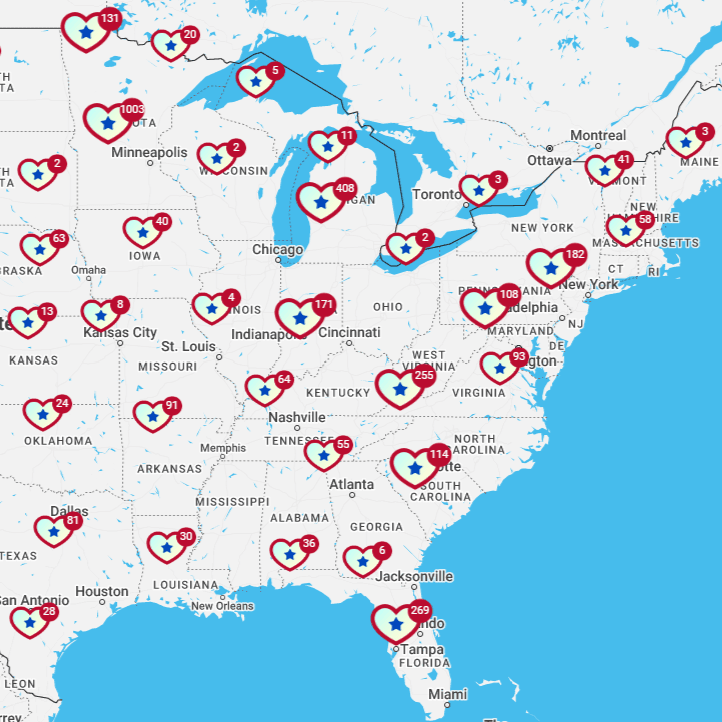
How Many Political Parties Are There in the United States?
It’s common knowledge that the American political system is currently dominated by two major parties: the Democratic Party and the Republican Party. That’s why it’s currently called the “two-party system,” right? Well, mostly.
While it’s true that the Democrats and Republicans represent by far the two largest, most dominant, well-funded and organized political parties in the United States, they are far from the only political parties operating today. So let’s take a look at the full breadth of political party representation in the United States, how we got here, and what partisan trend lines look like from here.
How Many Political Parties Are There?
Ballotpedia's data reports that as of November 2022, there were 53 distinct political parties with ballot access in the United States. Ballotpedia also reported the existence of 209 state-level political parties at that time.
However, the answer to the question of how many political parties there are in the United States is not really as simple as these numbers might suggest.
There are a number of questions that one must ask when calculating the number of political parties. Namely, what counts as a political party? Does a political party have to have ballot access to count toward our total? Does it have to have a certain number of active members? Does it have to be actively running and supporting candidates in local or national elections?
Below, we'll dive into more of the nuances of the United States' diverse political landscape.
What Is a Political Party?
This is kind of a weird question to answer, because we all sort of “get” what a political party is without really understanding what a political party actually is. So let’s break it down: essentially, a political party is an organized group of ideologically-similar leaders, voters, and operatives who have agreed to bind together for the sake of electoral influence and political efficiency.
What do we mean by political efficiency? In a party system, it can significantly streamline things for voters when they see a race between a Democrat and Republican, vs. two completely independent candidates. Less active research is needed on behalf of the voter when party affiliation is already doing the heavy lifting for them.
Especially after centuries of two-party dominance, the average voter in the U.S. has a general idea of what to expect from a Republican candidate vs. a Democratic candidate. And unfortunately, in our oversaturated attention economy, the quicker you can leave an impression on a voter, the better. Voters have less and less time to do thorough research on their own, so the major parties are all too happy to exploit this inefficiency by making it “easier” on voters by setting up a slate of policy positions and attitudes they can reasonably expect from any office holder in any given party.
Party organization also makes fundraising significantly more lucrative and efficient – especially with platforms like ActBlue and WinRed, in which donors aren’t sending money to a specific candidate or campaign, but rather the entire party apparatus altogether, who then determine which specific races could benefit most from the donation. Having tightly organized parties makes it much simpler to raise and spend campaign funds and forge political alliances – though this comes at the expense of a wider array of democratic options and the potential for hardcore political gridlock, as we’ve seen play out in the last few generations of national political leadership.
The Two Major Parties: Democrats and Republicans
Let’s get the two major parties out of the way – these are the parties that we’re no doubt all familiar with, because they have come to dominate every inch of the political system in America. The Democratic Party and the Republican Party. One side, ostensibly “liberal,” and the other side, ostensibly “conservative,” have positioned themselves as each other’s natural challenger. Both parties want voters to think they have no other option when it comes time to cast their vote: you’re either voting Democratic or Republican. Even if you vote independent or write-in a candidate, the popular narrative in the U.S. is that any vote not for a Democrat is, in effect, a vote for a Republican. And any vote not for a Republican becomes, in effect, a vote for a Democrat.
This is the unfortunate, zero-sum reality that both parties want to present as an inevitable reality in America: even if you don’t fully support either the Democrats or Republicans, not voting for one of them means improving the other’s position. And you certainly don’t want the other side to win, right? It’s a race to the bottom that only serves to strengthen the power and position of both major parties. What’s in the interest of the Democratic and Republican parties is not what’s in the interest of the American people. Keep that in mind.
Throughout American history, in the period of two-party rule (from roughly the Civil War on), Democrats and Republicans have traded power positions, both nationally, at the state-level, at around the same levels.
The Rise of Third Parties and Independents
As popular distrust in both major parties has waned in recent years, various third party organizations, as well as individual independent leaders, have made their presence felt in American politics.
Currently, in America, the largest organized third parties are the Green Party and the Libertarian Party.
The Green Party positions itself to the left of the Democratic Party, championing environmental issues as their focal point. The Libertarian Party positions themselves on the right, but somewhat to the left of the Republican Party, primarily supporting small government intervention in society, both economically and morally/religiously.
At a smaller scale, the left-wing Democratic Socialists of America have risen in popularity ever since Bernie Sanders ran for the Democratic Party’s nomination back in 2016.
Sanders in particular is an interesting flashpoint for the position of independent politicians in America. First elected as an independent mayor in Burlington, Vermont, Sanders won election to the U.S. House of Representatives and the Senate as an explicitly independent candidate, outside of Democratic Party support whatsoever. Though Sanders caucuses with the Democratic Party in the Senate (meaning he generally votes with the majority of Democrats vs. Republicans) and ran for the Democratic nomination in 2016 and 2020, Sanders holds no official party affiliation. Neither does the other senator from Vermont, the independent Angus King. As of 2023, they are the only two independent Senators currently serving, and both currently caucus with the Democratic Party.
Even today, new parties are emerging. After his longshot presidential bid catapulted him into national consciousness, Andrew Yang founded the Forward Party in an attempt to elect representatives who don’t feel represented by either Democrats or Republicans.
Historical Independents and Third-Party Movements
In key moments throughout American history, popular discontent with the standard Democratic and Republican offerings has spurred support of independent and/or third party candidates, particularly in Congress and in the White House.
Consider independent Ross Perot’s record-breaking independent runs for the White House in 1992 and 1996, where despite not winning any single state, he still walked away with a mind-blowing 19% of the popular vote in 1992 and 8% in 1996 – the most votes an independent candidate for president has ever won, by a crushing margin.
In other presidential elections, some third-party challengers have managed to make noise and win some electoral votes – in particular, Theodore Roosevelt’s Progressive Party challenge to both the Democratic and Republican parties managed to win 6 states, 88 electoral votes, and 27% of the popular vote – a total so large that he actually received more votes and won more states than the incumbent President, Howard Taft of the Republican Party. This represents by far the most successful third party challenge in the context of a presidential election in American history. Of course, Roosevelt’s situation was unique – he was a former president himself, under the Republican Party. After he had a falling out with his Republican successor – Taft – he decided to form his own party and run for the presidency yet again.
How to Support Independents and Third Parties
Though the U.S. has a long history of independent campaigns and third party organizations, the flat truth remains that politics, especially at the national level, remains dominated by the two major parties. That’s why organizations like GoodParty.org have developed tools and resources to help voters identify and learn about independent candidates and tools and resources to help independent candidates run for office themselves. Get involved here if you’re one of the many Americans fed up with the chokehold the two-party system has on our politics.
